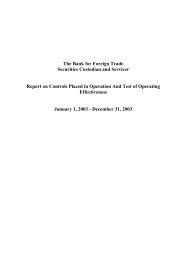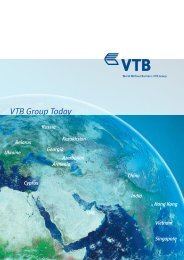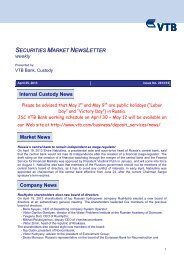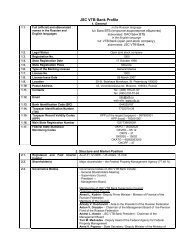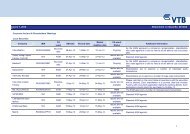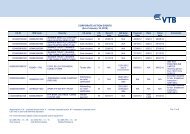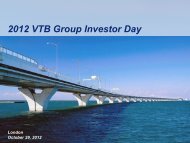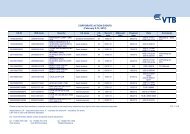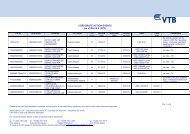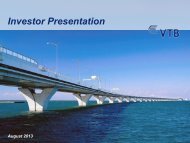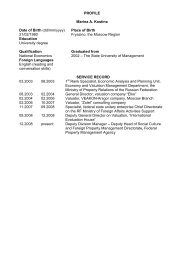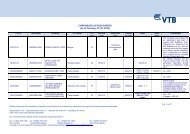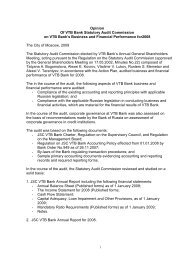Annual report 2011 - VTB
Annual report 2011 - VTB
Annual report 2011 - VTB
- No tags were found...
Create successful ePaper yourself
Turn your PDF publications into a flip-book with our unique Google optimized e-Paper software.
<strong>VTB</strong> BankNotes to the Consolidated Financial Statements – 31 December <strong>2011</strong> and 2010(in billions of Russian Roubles)5. Summary of Principal Accounting Policies (continued)Financial assets (continued)The fair value of investments that are actively traded in active financial markets is determined by reference to quotedcurrent bid prices. For investments where there is no active market, fair value is determined using valuationtechniques. Such techniques include using recent arm’s length market transactions, reference to the current marketvalue of another instrument, which is substantially the same, and discounted cash flow analysis.Financial assets classified as available-for-sale that would have met the definition of loans and receivables may bereclassified if the Group has the intention and ability to hold these financial assets for the foreseeable future or untilmaturity.Derecognition of financial assetsA financial asset (or, where applicable a part of a financial asset or part of a group of similar financial assets) isderecognized where:the rights to receive cash flows from the asset have expired; orthe Group has transferred its rights to receive cash flows from the asset, or retained the right to receive cashflows from the asset, but has assumed an obligation to pay them in full without material delay to a third partyunder a ‘pass-through’ arrangement and has no obligation to pay amounts to eventual recipients unless itcollects equivalent amounts from the original assets. The Group either (a) has transferred substantially all therisks and rewards of the asset, or (b) has neither transferred nor retained substantially all the risks andrewards of the asset, but has transferred control of the asset.Where the Group has transferred its rights to receive cash flows from an asset and has neither transferred norretained substantially all the risks and rewards of the asset nor transferred control of the asset, the asset isrecognized to the extent of the Group’s continuing involvement in the asset. Continuing involvement that takes theform of a guarantee over the transferred asset is measured at the lower of the original carrying amount of the assetand the maximum amount of consideration that the Group could be required to repay.Where continuing involvement takes the form of a written and/or purchased option (including a cash-settled option orsimilar provision) on the transferred asset, the extent of the Group’s continuing involvement is the amount of thetransferred asset that the Group may repurchase, except that in the case of a written put option (including a cashsettledoption or similar provision) on an asset measured at fair value, the extent of the Group’s continuinginvolvement is limited to the lower of the fair value of the transferred asset and the option exercise price.Restructuring of financial assetsThe Group from time to time may restructure some of its financial assets. This mostly relates to loans andreceivables. The accounting treatment of such restructuring is conducted in the following basic scenarios:If the currency of the loan has been changed the old loan is derecognized and the new loan is recognized. Asa result the new loan will be recognized which requires the estimation of a new effective interest rate. If thenew effective interest rate is below the market interest rate, the loss on initial recognition is recognized in the<strong>report</strong>ing period.If the loan restructuring is not caused by the financial difficulties of the borrower but the cash flows wererenegotiated on the favorable terms for the borrower: in this case the loan is not recognized as impaired. Theloan is not derecognized but the new effective interest rate is determined based on the remaining cash flowsunder the loan agreement till maturity. If the new effective interest rate is below the market rate at the date ofrestructuring, the new carrying amount is calculated as the fair value of the loan after restructuring, being thepresent value of the future cash flows discounted using the market rate at the date of restructuring. In thiscase, the difference between the carrying amount before restructuring and the fair value of the loan afterrestructuring is recognized as a loss on loan restructuring.If the loan is impaired after being restructured, the Group uses the original effective interest rate in respect ofthe new cash flows after renegotiation to estimate the recoverable amount of the loan. The difference betweenthe recalculated present value of the new cash flows taking into account collateral and the carrying amountbefore restructuring is included in the provision charges for debt financial assets for the period.Securitization of financial assetsAs part of its operational activities, the Group securitizes financial assets, generally through the transfer of these assetsto special purpose entities that issue debt securities to investors. The transferred securitized assets may qualify forderecognition in full or in part. Interests in the securitized financial assets may be retained by the Group and are primarilyclassified as loans to customers. Gains or losses on securitizations are based on the carrying amount of the financialassets derecognized and the retained interest, based on their relative fair values at the date of transfer.15



